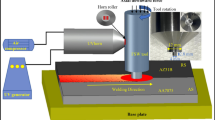Abstract
Liquid penetration induced (LPI) cracking is investigated during friction stir spot weld of AZ91, AZ31 and AM60 magnesium alloys. A combination of stir zone temperature measurement and detailed metallography has revealed differences in the cracking tendencies of different magnesium alloys when the dwell time during spot welding is varied. LPI cracking in AZ91 spot welds involves the following sequence of events: the formation of \(\alpha-\hbox{Mg}\,+\,\hbox{Mg}_{17}\hbox{Al}_{12}\) eutectic films in the thermo-mechanically affected zone (TMAZ) region immediately adjacent to the stir zone extremity, engulfment of melted eutectic films as the stir zone width increases during the dwell period, penetration of α−Mg grain boundaries and crack propagation when torque is applied by the rotating tool. Cracking occurs early in the dwell period during AZ91 spot welding and almost the entire stir zone is removed when the rotating tool is withdrawn. However, crack-free AZ31 and AM60 spot welds are produced when a dwell time of 4 s is used since the stir zone temperatures are much higher than the α-Mg + Mg17Al12 eutectic temperature (437 °C) and melted eutectic films dissolve rapidly following their engulfment by the growing stir zone. In contrast, the temperature during the dwell period in AZ91 spot welding is close to 437 °C and melted eutectic films are not completely dissolved so that spot welds produced using a dwell time of 4 s exhibit LPI cracking.













Similar content being viewed by others
References
Gerlich A, Su P, North TH, In: Neelameggham NR, Kaplan HI, Powell BR (TMS, 2005) Magnesium Technology 2005. pp 383–388
Su P, Gerlich A, North TH, SAE Technical Series, 2005-01-1255
Aritoshi M, Tomita T, Ikeuchi K, Takahashi M, Tani K, M. Ueda and Sakurai T, Preprints of the National Meeting of Jpn Weld Soc (2006.9) 123 (in Japanese)
Ikegami H, Tsumura T, Ueda M, Nakata K, Preprints of the National Meeting of Jpn Weld Soc (2006.9) 141 (in Japanese)
Yamamoto M, Su P, Gerlich A, North TH, Shinozaki K (2007) J Jpn Weld Soc 25(1):208 (in Japanese)
Yamamoto M, Su P, A. Gerlich and North TH, SAE Technical Series, (2007), #2007-01-1700
Yamamoto M, Gerlich A, North TH, Shinozaki K (2007) accepted in Proc IWJC-Korea Int Weld./Joining Conf, Seoul, Korea, May 2007
Yamamoto M, Gerlich A, North TH, Shinozaki K (2007) Sci Tech Weld Joining 12(3):208
SU P, Gerlich A, Yamamoto M, North TH (2006) In: Pekguleryuz MO, Mackenzie LWF (eds) Proc Int Symp on ‘Magnesium technology in the global age’, Montreal, Canada, October 2006, CIM, pp 479–492
Japan Magnesium Association (2000) In: Handbook of advanced magnesium technology. Kallos Publishing, Japan, p 90
Bassani P, Gariboldi E, Tuissi A (2005) J Thermal Anal Calorimet 80:739
Gerlich A, Cingara GA, North TH (2006) Metall Trans 37A:2773
Gerlich A, Su P, North TH (2005) Sci Tech Weld Joining 10(6):647
Fernandes PJL, Jones DRH (1997) Int Mat Rev 42(6):251
Ludwig W, Pereiro-lopez E, Bellet D (2005) Acta Mater 53:151
Su P, Gerlich A, North TH, Bendzsak GJ (2007) Metall Trans 38A:584
Whelan MJ (1969) Met Sci J 3:95
Reiso O, Overlie H-G, Ryum N (1990) Metall Trans 21A:1689
Lathabai S, Barton KJ, Harris D, Lloyd PG, Viano DM, Mclean A (2003) In: Magnesium Technology 2003. Kaplan HI (TMS, 2003), pp 157–162
Japan Magnesium Association (2000) In: Handbook of advanced magnesium technology. Kallos Publishing, Japan, p 132
Acknowledgements
The authors wish to acknowledge financial support from the Natural Sciences and Engineering Research Council of Canada during this project.
Author information
Authors and Affiliations
Corresponding author
Appendix
Appendix
Dissolution of a Melted Eutectic Films during AZ91, AM60 and AZ31 Spot Welding
Figure A.1 shows part of the binary Mg–Al equilibrium phase diagram:
The driving force for diffusion and dissolution of liquid droplets is determined by the relation:
For AZ91; k = 0.4, \(C_{T_1 } ^{\alpha /\beta }=9\% \,,\,C_{T_2 } ^{\alpha /liq}=13\% \,,\,C_{T_2 } ^{liq/\alpha }=33\% \,,\,T_2 =710\,\hbox{K}\)
For AM60; k = 0.7, \(C_{T_1 } ^{\alpha /\beta }=6\% \,,\,C_{T_2 } ^{\alpha /liq}=13\% \,,\,C_{T_2 } ^{liq/\alpha }=33\% \,,\,T_2 =710\,\hbox{K}\)
For AZ31; k = 1.0, \(C_{T_1 } ^{\alpha /\beta }=3\% \,,\,C_{T_2 } ^{\alpha /liq}=13\% \,,\,C_{T_2 } ^{liq/\alpha }=33\% \,,\,T_2 =710\,\hbox{K}\)
The diffusion coefficient depends on the relation:
where\( R=8.314\times 10^{-3} \) kJ/(mol · K) and the diffusion rate of Al in Mg is [20]:
For AZ91;
For AM60;
For AZ31;
The relation between the half-thickness of a plate-shaped liquid droplet and the time available for dissolution at 710, 733, 773, 787 and 823 K is determined by the relation:
It is worth noting that this equation is a first order approximation and is derived by assuming no overlapping of the concentration fields from neighboring films.
Rights and permissions
About this article
Cite this article
Yamamoto, M., Gerlich, A., North, T.H. et al. Cracking in the stir zones of Mg-alloy friction stir spot welds. J Mater Sci 42, 7657–7666 (2007). https://doi.org/10.1007/s10853-007-1662-2
Received:
Accepted:
Published:
Issue Date:
DOI: https://doi.org/10.1007/s10853-007-1662-2





